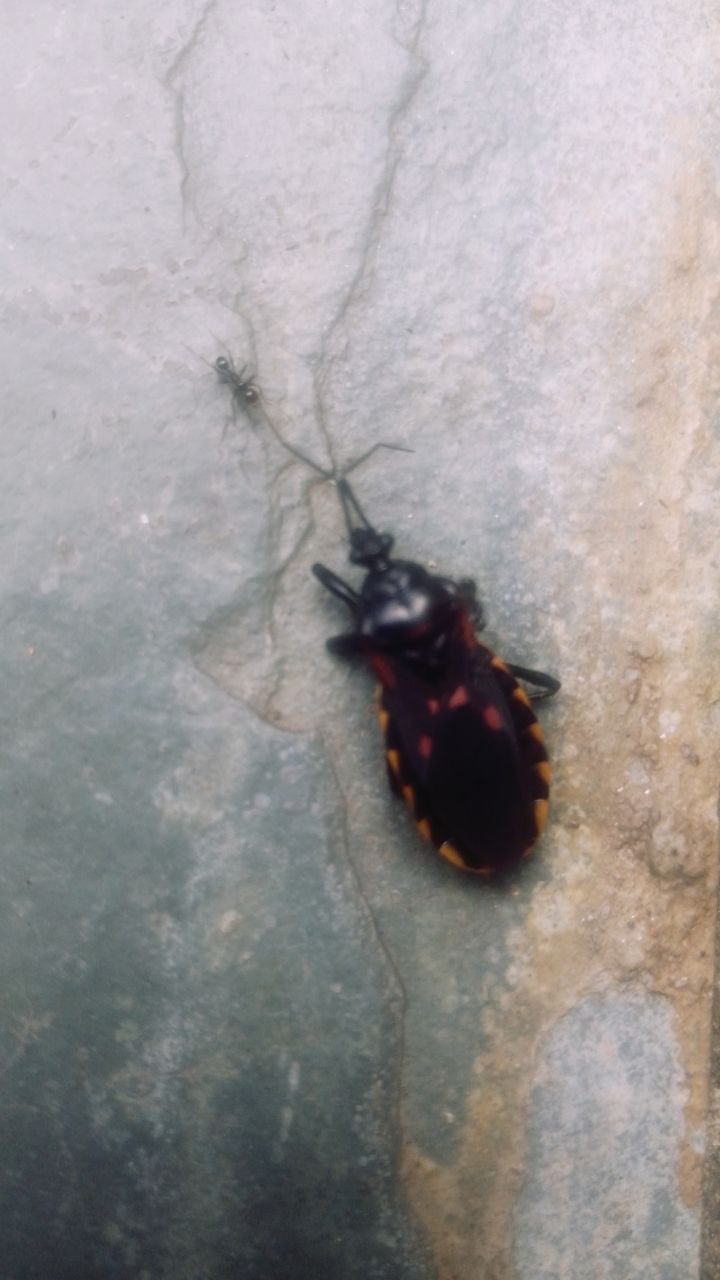
(El segundo encontrado/The second found))
¡Auxilio, chipos en casa!
Ante la aparición de estos peculiares insectos, es común alarmarse. Normalmente viven entre las grietas de las paredes, huecos de árboles, placas de viviendas y en madrigueras donde suelen alimentarse de roedores y aves, pero, también se alimentan de sangre de animales y humanos, son insectos nocturnos y se ven atraídos hacia las casas por las luces, eso incluye la iluminación de televisores y pantallas. También son los principales transmisores de la Tripanosomiasis o la enfermedad del Mal de Chagas.
Se pueden ver en todo el centro y Suramérica. Su picadura no es la forma más frecuente de la transmisión de la enfermedad, sino, a través de sus heces. El mal de chagas es una enfermedad que en la mayoría de los casos permanece asintomáticas por largos años, aunque a veces la enfermedad se manifiesta al poco tiempo de ocurrir la infección del parásito.
En casa de mi tía, que vive en el Hatillo, Venezuela, ya hemos encontrado dos. Es una zona hermosa y montañosa, en la que normalmente hemos visto insectos muy peculiares hasta animales exóticos como perezosos. Pero, la situación es distinta al toparnos con un chipo, pues aunque no todos están infectados, una gran mayoría transmite una enfermedad que prácticamente no tiene cura si no se detecta a tiempo. Por ello es importante, y esa es la intención del post, saber qué hacer al toparnos con uno.
Lo primero que recomiendan los expertos es calmarse, no agarrarlos con las manos ni matarlos, colocarse guantes o con una bolsa aislante, tratar de atraparlos con un frasco de vidrio o caja y de preferencia, llevarlos a, en el caso de Venezuela, al Instituto de Medicina Tropical de la UCV a fin de que estudien si está infectado y hacer el despistaje de la enfermedad en caso de que sí. Es importante ya que existen desparasitantes que si son usados a tiempo, evitan el desarrollo de la infección.
Si se presenta alguna erupción en la piel, hinchazón, dolor o fiebre, posterior a la aparición del insecto, también se debe acudir a hacer despistaje de la enfermedad. Aunque como ya mencioné, generalmente la trasmisión se produce por las heces del insecto más que por las picaduras, por ello la importancia de lavar frutas y verduras antes de comerlas. De igual manera, evitar comer en sitios rurales proclives a la aparición de Chipos, que no cumplan con las medidas de asepsia básicas al preparar los alimentos.
En nuestro caso, mi tío llevó el segundo chipo encontrado (el de la primera foto) a la UCV y por fortuna no estaba infectado.
En Caracas hay muchas zonas en dónde se encuentran, el llamado entonces es a que estemos alertas en caso de verlos y no alarmarse, pero sí actuar con coherencia.
Feliz día para todos y a cuidarse mucho!


(El primero encontrado/The first found))
English
Help, a chipo at home! Before the appearance of these peculiar insects, it is common to be alarmed. They normally live between the cracks of the walls, hollows of trees, plates of houses and in burrows where they usually feed on rodents and birds, but, they also feed on the blood of animals and humans, they are nocturnal insects and are attracted to houses by lights, that includes the lighting of televisions and screens. They are also the main transmitters of Trypanosomiasis or Chagas disease. They can be seen throughout Central and South America. Their bite is not the most frequent way of transmitting the disease, but through their feces. Chagas disease is a disease that in most cases remains asymptomatic for long years, although sometimes the disease manifests itself shortly after the infection of the parasite.
At my aunt's house, who lives in El Hatillo, Venezuela, we have already found two. It is a beautiful and mountainous area, where we have usually seen very peculiar insects and even exotic animals such as sloths. But, the situation is different when we come across a chipo, because although not all are infected, a great majority transmits a disease that has practically no cure if not detected in time. That is why it is important, and that is the intention of this post, to know what to do when we come across one.
The first thing experts recommend is to calm down, do not grab them with your hands or kill them, put on gloves or an insulating bag, try to catch them with a glass jar or box and preferably, take them to, in the case of Venezuela, to the Institute of Tropical Medicine of the UCV so that they can study if they are infected and make the screening of the disease in case they are. It is important since there are dewormers that, if used in time, avoid the development of the infection.
If there is any skin rash, swelling, pain or fever, after the appearance of the insect, you should also go to do a screening for the disease. Although, as I already mentioned, transmission generally occurs through the insect's feces rather than through bites, hence the importance of washing fruits and vegetables before eating them. Likewise, avoid eating in rural places prone to the appearance of Chikos, which do not comply with the basic aseptic measures when preparing the food.
In our case, my uncle took the second chipo found (the one in the first photo) to the UCV and fortunately it was not infected.
In Caracas there are many areas where they are located, the call then is to be alert in case of seeing them and not to be alarmed, but to act with coherence.
Happy day to all and take good care of yourselves!
Photographs of my property
Separators
Original content for Hive
© 2023, @astrea. All rights reserved.




